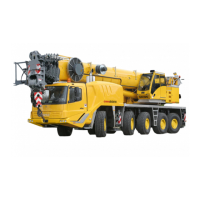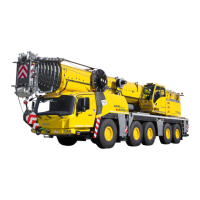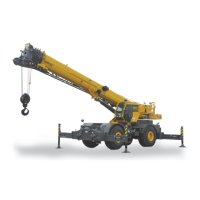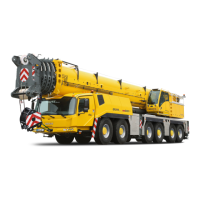GROVE Published 10-21-2010, Control# 198-04 3-1
5540F/YB5515 SERVICE MANUAL ELECTRIC SYSTEM
SECTION 3
ELECTRIC SYSTEM
GENERAL
To aid in the understanding and troubleshooting of an
electrical system, review the terms and information that
follows.
Electrical Energy - power which comes from the movement
of electrons. Electrons are particles with a negative charge.
Electrons will collect around particles with a positive charge,
called protons, until an electrical imbalance occurs.
Amperage - rate of flow of electrons (CURRENT), measured
in amperes.
Voltage - the electromotive force (EMF) which causes
electrons to move through an electrical circuit, measured in
volts.
Resistance - any resistance to flow of electrons in an
electrical circuit, measured in Ohms.
Ohm’s Law - “Electric current increases in direct relation to
the voltage and decreases in relation to the amount of
resistance in any circuit.”
To Find:
•EMF (Voltage) - Multiply CURRENT (amps) by
RESISTANCE (Ohms).
• RESISTANCE (Ohms) - Divide EMF (voltage) by
CURRENT (amps).
• CURRENT (Amps) - Divide EMF (voltage) by
RESISTANCE (Ohms).
Consider the following when trying to find trouble in an
electrical system:
1. Current always flows from (+) positive to (-) negative, or
from the point of highest voltage.
2. Because the system used on this machine is a negative
ground system, current that leaves the supply (battery)
returns to the supply (battery).
3. In series circuit arrangements, the voltage is completely
used in the circuit when the current is flowing. In parallel
circuit arrangements, the voltage is constant.
4. When the voltage is constant, resistance controls the
rate of current (amps) in the circuit. Refer to Ohm’s Law.
Comparing Electrical System to a Hydraulic
System
The electrical system is in many ways similar to a hydraulic
system. Both systems need a “pump” to cause the flow
which generates the energy. Each system needs a complete
circuit so the flow can return to storage or supply. Both
systems need “valves” to control the flow through the
system. See Table 3-1.
Table 3-1
Comparing Electrical System and Hydraulic System
Magnetism
When electrical current passes through a conductor it
creates a magnetic field around the conductor. This
magnetic field can be used to induce current into a second
conductor. This is the principle behind generators, coils,
relays and solenoids, which are the working components of
the electrical system. These components will be covered
further in the discussion of the electrical system.
MAIN ELECTRICAL SYSTEM
General
The electrical system used on this machine is a 12 volt,
direct current (DC) system with a (-) negative ground. The
power is supplied by one (two with diesel engine cold start)
12 volt battery.
An alternator supplies the necessary current (amps) for
system operation, and charging of the batteries, when the
engine is running. A voltage regulator on the alternator
controls the voltage in the charging system. A warning light
in the dash indicates when the alternator is not charging the
battery.
CAUTION
Know the electrical circuit before connecting or
disconnecting an electrical component. A wrong
connection can cause personal injury or damage to the
component and/or system.
ELECTRICAL SYSTEM HYDRAULIC SYSTEM
Alternator Pump
Battery Reservoir
Switches Valves
Wires and Cables Tubes and Hoses
Diodes Check Valves
Volts PSI or kPa
Amps gpm or L/min
Ohms Resistance
Reference Only
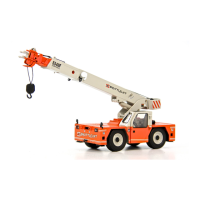
